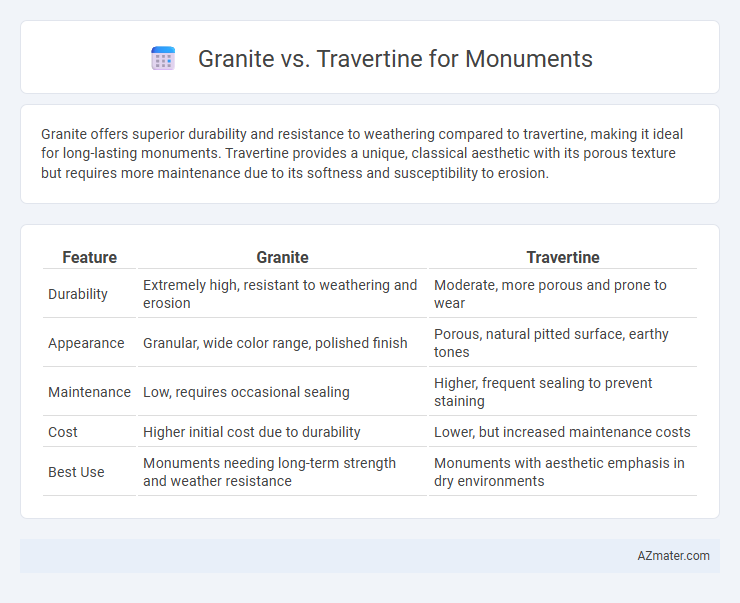Granite offers superior durability and resistance to weathering compared to travertine, making it ideal for long-lasting monuments. Travertine provides a unique, classical aesthetic with its porous texture but requires more maintenance due to its softness and susceptibility to erosion.
Table of Comparison
| Feature | Granite | Travertine |
|---|---|---|
| Durability | Extremely high, resistant to weathering and erosion | Moderate, more porous and prone to wear |
| Appearance | Granular, wide color range, polished finish | Porous, natural pitted surface, earthy tones |
| Maintenance | Low, requires occasional sealing | Higher, frequent sealing to prevent staining |
| Cost | Higher initial cost due to durability | Lower, but increased maintenance costs |
| Best Use | Monuments needing long-term strength and weather resistance | Monuments with aesthetic emphasis in dry environments |
Granite vs Travertine: A Comprehensive Comparison
Granite offers superior durability and resistance to weathering, making it an ideal choice for monuments that require long-lasting strength and minimal maintenance. Travertine, while aesthetically appealing with its natural porous texture and earth-toned colors, is more susceptible to erosion and staining, demanding frequent sealing when used for outdoor monuments. For monuments exposed to harsh environmental conditions, granite's density and hardness provide enhanced protection against aging and structural damage compared to travertine.
Understanding Granite: Properties and Appeal
Granite boasts exceptional durability, resistance to weathering, and a dense, hard composition, making it ideal for long-lasting monuments exposed to outdoor elements. Its granular texture and wide range of natural colors enhance visual appeal while offering low porosity that minimizes staining and erosion. These properties contribute to granite's popularity for monuments that require both aesthetic elegance and structural integrity.
Exploring Travertine: Qualities and Characteristics
Travertine offers a porous, sedimentary texture with natural pitting and a warm, earthy color palette that enhances the monument's aesthetic appeal. Its lightweight properties compared to granite make it easier to sculpt intricate designs and detailed carvings. While less durable than granite, travertine's timeless elegance and unique veining provide a distinguished, classic look ideal for historic and commemorative monuments.
Durability Showdown: Granite vs Travertine Monuments
Granite exhibits superior durability compared to travertine, making it the preferred choice for monuments exposed to harsh weather and heavy wear. Its high density and low porosity provide exceptional resistance to erosion, chipping, and staining, preserving inscriptions and structural integrity over time. Travertine, while aesthetically appealing due to its natural pitted texture, is softer and more prone to surface weathering and acid rain damage, which can accelerate deterioration in outdoor monument applications.
Aesthetic Differences: How Granite and Travertine Enhance Monuments
Granite exhibits a polished, speckled appearance with vibrant hues and natural grain variations, providing monuments with a sleek, durable finish that resists weathering and maintains color over time. Travertine offers a textured, porous surface with earthy tones ranging from cream to rust, adding a classic, rustic charm that evokes timeless elegance and highlights intricate carvings. The choice between granite and travertine influences the monument's visual impact, balancing permanence with artistic expression through distinct surface qualities and color palettes.
Maintenance Requirements: Keeping Granite and Travertine Monuments Pristine
Granite monuments require minimal maintenance due to their dense, non-porous structure, resisting stains, scratches, and weathering, making them ideal for long-term outdoor durability. Travertine monuments demand more frequent cleaning and sealing to prevent surface erosion, staining, and discoloration caused by exposure to moisture and pollutants. Regular inspection and proper sealing of travertine can extend its lifespan, but granite remains the superior choice for low-maintenance monument installations.
Cost Analysis: Granite vs Travertine for Memorial Projects
Granite typically costs between $40 to $100 per square foot, making it a durable yet more expensive option for memorial projects compared to travertine, which ranges from $30 to $70 per square foot. Maintenance expenses also vary, as granite resists weathering and staining better than travertine, reducing long-term preservation costs. The choice between granite and travertine significantly impacts overall budget planning due to differences in initial purchase price and required upkeep for monuments.
Weather Resistance: Which Stone Withstands the Elements?
Granite exhibits superior weather resistance compared to travertine, making it the preferred choice for monuments exposed to harsh elements. Its dense, non-porous structure resists moisture, temperature fluctuations, and erosion without significant degradation. Travertine, while aesthetically appealing, is more porous and susceptible to weathering, often requiring sealing and maintenance to preserve its integrity over time.
Environmental Impact: Sustainability of Granite and Travertine
Granite exhibits greater sustainability due to its durability and low maintenance, reducing the need for frequent replacements and minimizing resource consumption over time. Travertine, while natural and biodegradable, requires more intensive quarrying processes that can lead to significant landscape disruption and higher energy use. Choosing granite for monuments supports environmental preservation through longer lifespan and lower ecological footprint in extraction and maintenance.
Choosing the Right Stone: Granite or Travertine for Your Monument
Granite offers unparalleled durability and resistance to weathering, making it ideal for monuments exposed to harsh climates and heavy foot traffic, while travertine provides a timeless, textured appearance with its unique porous surface, suitable for decorative and historical monuments. Granite's hardness and low porosity ensure long-lasting inscriptions and reduced maintenance, whereas travertine requires sealing to prevent erosion and staining but excels in creating a classic, elegant aesthetic. Selecting between granite and travertine depends on the monument's location, intended longevity, and desired visual impact, balancing resilience with style.

Infographic: Granite vs Travertine for Monument
 azmater.com
azmater.com